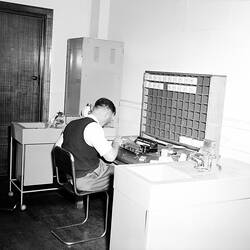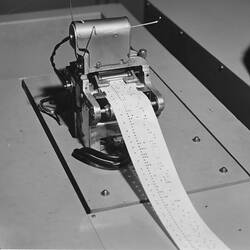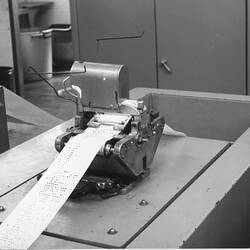Summary
Paper tape, part of a collection of paper tape programs and sub-routines used for input to CSIRAC. This is a program tape.. The program provided a means of displaying the instructions in a computer program in a way more easily read. It is part of the official CSIRAC Paper Tape Library.
The collection includes the original University of Melbourne Computation Laboratory Paper Tape Library of 12 hole tapes of subroutines and programs, and program and data tapes from staff and outside users.
Most of the paper tapes were 12-track punched paper tapes. 5 hole paper tapes were used primarily for data input and output rather than program input. However, 5 hole program tapes could be produced by using Interprogram, an English language programming system rather than using machine language.
Each tape has a 'T' number. The Computation Laboratory Paper Tape Library consisted of tapes with a tape number less than 700. There were not 700 tapes but the number 700 was arbitrarily chosen to separate the Computation Laboratory Library tapes from user tapes.
Details of this program:
Because of the difficulty in reading binary data, it is convenient for most users to have a means of displaying the instructions in a computer program in a way more easily read. With CSIRAC this type of representation is known as a Tape Symbol Print (TSP). Here the high (most significant) and low (least significant) bits of the instruction address are represented as two 32-scale numbers and the source and destination codes are represented by one- or two- letter mnemonics (symbols) as described in the CSIRAC Programming Manual.
The Tape Symbol Print program is read into the computer in the usual way, then under its control a 12-hole tape placed in the reader is read and converted into TSP notation. Control designations are also converted to mnemonic form. A Tape Symbol Print (listing) is provided for each tape in the CSIRAC Paper Tape Library.
As an example the computer instruction in binary of 11111110111101011000 is represented in TSP notation as 31 27 K PS
With CSIRAC, program material read from 12-hole paper tape is assembled into 'words' of 20 binary digits{bits) , each of which can have the value 0 or 1, and is then stored in the computer memory. The 20-bit word is notionally divided into 4 groups of 5 bits. Each group of 5 bits can represent a number in the range 0-31 and is known as 32-scale representation. From left to right these groups in an instruction are :
high (most significant) bits of instruction address
low (least significant) bits of instruction address
source code
destination code
There are various versions of the Tape Symbol Print program and this particular version outputs the TSP of a a block of memory to the Teleprinter.
More Information
-
Collection Names
CSIRAC Collection, CSIRAC Archive Collection, CSIRAC Paper Tape Library Collection
-
Collecting Areas
-
Acquisition Information
Donation from Computer Science & Software Engineering Department, University of Melbourne (The), by Jul 2003
-
User
University of Melbourne (The), Grattan Street, Parkville, Greater Melbourne, Victoria, Australia, 1955-1960
-
Format
Paper Tape, 12 hole
-
Classification
-
Category
-
Discipline
-
Type of item
-
Keywords
Computing, CSIRAC (Computer), First Generation Computers, Mainframe Computers, Making History - CSIRAC



